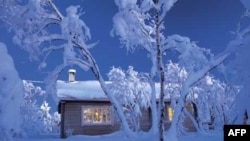(Səsli faylı yükləmək üçün bu linkin üzərində sağ düyməyə basıb, menyudan "Yadda saxla"nı seçin: MP3-ü yükləyin)
Large amounts of snow fell in some American cities last month. One storm hit the East Coast, causing flight cancellations and temporarily stopping traffic in some areas.
Snow is a subject of great interest to weather experts. They sometimes have difficulty estimating where, when or how much snow will fall. One reason is that heavy amounts of snow fall in surprisingly small areas. Another reason is that a small change in temperature can mean the difference between snow and rain.
Just what is snow, anyway? Snow is a form of frozen water. It contains groups of ice particles called snow crystals. These crystals grow from water droplets in cold clouds. They usually grow around dust particles.
All snow crystals have six sides, but they grow in different shapes. The shape depends mainly on the temperature and water levels in the air.
Snow crystals grow in one of two designs – plate-like and columnar. Plate-like crystals are flat. They form when the air temperature is about fifteen degrees below zero Celsius. Columnar snow crystals look like sticks of ice. They form when the temperature is about five degrees below zero.
The shape of a snow crystal may change from one form to another as the crystal passes through levels of air with different temperatures. When melting snow-crystals or raindrops fall through very cold air, they freeze to form small particles of ice, called sleet. Groups of frozen water-droplets are called snow pellets. Under some conditions, these particles may grow larger and form solid pieces of ice, or hail. Hail can be dangerous to people, animals and property.
When snow crystals stick together, they produce snowflakes. Snowflakes come in different sizes. As many as one hundred crystals may join to form a snowflake larger than two and one-half centimeters. Under some conditions, snowflakes can form that are five centimeters long. Usually, this requires near-freezing temperatures, light winds and changing conditions in Earth’s atmosphere.
Snow contains much less water than rain. About two and one-half centimeters of rain has as much water as fifteen centimeters of wet snow. About seventy-six centimeters of dry snow equals the water in two and one-half centimeters of rain.
Much of the water the world uses comes from snow.
Snowfall helps to protect plants and some wild animals from winter weather. Fresh snow is made largely of air trapped among the snow crystals. Because the air has trouble moving, the movement of heat is limited.
Generally, snow and ice appear white. This is because the light we see from the sun is white. Most natural materials take in some sunlight. This gives them their color. However, when light travels from air to snow, some light is sent back, or reflected. Snow crystals have many surfaces to reflect sunlight. Yet the snow does take in a little sunlight. It is this light that gives snow its white appearance.
Each year, the continental United States has an average of one hundred five snowstorms. An average storm produces snow for two to five days.
Snow may be beautiful, but it can be deadly. It is responsible for the deaths of hundreds of people in the United States every year. Many people die in traffic accidents on roads that are covered with snow or ice. Others die from being out in the cold, or from heart attacks caused by too much physical activity.
--------------------------------
Click on this exercise to improve your English vocabulary! Open
Improve your English comprehension skills with this activity! Open
Improve your English by learning the facts! Open
Click here to improve your English language listening skills! Open
Expand your English language skills with this activity! Open




